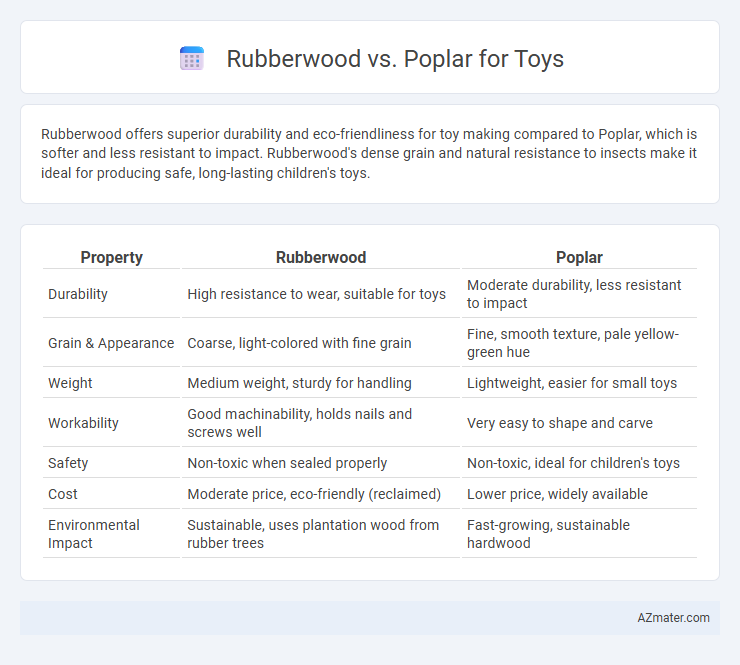Rubberwood offers superior durability and eco-friendliness for toy making compared to Poplar, which is softer and less resistant to impact. Rubberwood's dense grain and natural resistance to insects make it ideal for producing safe, long-lasting children's toys.
Table of Comparison
| Property | Rubberwood | Poplar |
|---|---|---|
| Durability | High resistance to wear, suitable for toys | Moderate durability, less resistant to impact |
| Grain & Appearance | Coarse, light-colored with fine grain | Fine, smooth texture, pale yellow-green hue |
| Weight | Medium weight, sturdy for handling | Lightweight, easier for small toys |
| Workability | Good machinability, holds nails and screws well | Very easy to shape and carve |
| Safety | Non-toxic when sealed properly | Non-toxic, ideal for children's toys |
| Cost | Moderate price, eco-friendly (reclaimed) | Lower price, widely available |
| Environmental Impact | Sustainable, uses plantation wood from rubber trees | Fast-growing, sustainable hardwood |
Introduction to Rubberwood and Poplar
Rubberwood, derived from the Para rubber tree (Hevea brasiliensis), is a sustainable hardwood prized for its durability and natural resistance to pests, making it ideal for toy manufacturing. Poplar, a fast-growing hardwood from the genus Populus, offers a lightweight and affordable option with a smooth grain and ease of machining. Both woods are non-toxic and commonly used in toy production, but Rubberwood's hardness and eco-friendly origin often make it preferable for long-lasting, safe children's toys.
Key Characteristics of Rubberwood
Rubberwood features a light, pale color with a fine, straight grain that enhances toy aesthetics and durability. Its medium hardness provides sufficient strength for safe, child-friendly toys while being easy to machine and finish. The wood's eco-friendly nature, sourced from sustainable plantations, makes it a popular choice for environmentally conscious toy manufacturers.
Key Characteristics of Poplar
Poplar wood is lightweight, soft, and easy to work with, making it ideal for detailed toy designs and smooth finishes. It has a fine, even texture and generally displays good paint adhesion, allowing vibrant, non-toxic coatings essential for safe children's toys. Compared to rubberwood, poplar offers greater flexibility and less density, reducing the risk of splintering and enhancing toy durability under everyday play conditions.
Durability Comparison: Rubberwood vs Poplar
Rubberwood offers higher durability for toys due to its dense grain and resistance to wear, making it ideal for lasting play items. Poplar, while lightweight and easy to work with, tends to be softer and more prone to dents and scratches, reducing its longevity. Choosing rubberwood ensures toys withstand rough handling and extended use better than poplar.
Safety and Toxicity for Toys
Rubberwood is a popular choice for toys due to its natural resistance to insects and mold, combined with the fact that it is a hardwood with low resin content, reducing the risk of toxic off-gassing. Poplar, being a softer hardwood, is generally less durable but is also considered non-toxic and safe for children's toys, especially when untreated or finished with non-toxic coatings. Both woods are preferred for safety, but ensuring absence of harmful finishes and adhesives is crucial to eliminate any toxicity risks in toys.
Workability and Ease of Crafting
Rubberwood offers excellent workability with its medium density and consistent grain, making it easy to cut, shape, and sand for toy manufacturing. Poplar, characterized by its lightweight and soft texture, is highly favored for effortless carving and painting, facilitating detailed and intricate toy designs. Both woods provide smooth finishes, but Rubberwood's durability and resistance to warping often make it a more practical choice for long-lasting toys.
Appearance and Finishing Qualities
Rubberwood features a light cream to yellowish-brown color with a straight grain that provides a smooth, even surface ideal for vibrant paint or clear finishes on toys. Poplar displays a pale greenish to creamy white tone with subtle streaks, offering excellent paint adhesion and a soft, uniform texture that enhances detailed finishing. Both woods allow for fine sanding and hold finishes well, but Rubberwood's slightly denser grain results in a more durable and polished appearance, making it highly suitable for durable, visually appealing toys.
Environmental Impact and Sustainability
Rubberwood is highly regarded for its sustainability because it is sourced from rubber trees that have completed their latex-producing lifecycle, repurposing wood that would otherwise be discarded, thus reducing deforestation and waste. Poplar, while fast-growing and renewable, often involves more intensive logging practices and lacks the same level of certification and reuse compared to rubberwood. Rubberwood's lower environmental footprint and its certification under sustainable forestry programs make it a preferred choice for eco-friendly toy manufacturing.
Cost Comparison of Rubberwood and Poplar
Rubberwood is generally more affordable than poplar, making it a cost-effective choice for toy manufacturing. The availability of rubberwood as a byproduct from rubber plantations reduces material costs, while poplar's price tends to be higher due to its limited supply and transportation expenses. Choosing rubberwood can significantly lower production expenses without compromising durability or safety.
Best Choice for Toy Making: Final Verdict
Rubberwood offers superior durability and resistance to wear, making it an ideal choice for toy making where safety and longevity are critical. Poplar is softer and easier to shape but lacks the strength and durability needed for toys subjected to frequent handling. For sturdy, safe, and long-lasting toys, rubberwood stands out as the best material choice.

Infographic: Rubberwood vs Poplar for Toy
 azmater.com
azmater.com